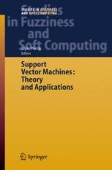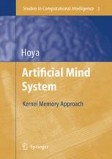Search
Search Results
-
Iterative Single Data Algorithm for Training Kernel Machines from Huge Data Sets: Theory and Performance
The chapter introduces the latest developments and results of Iterative Single Data Algorithm (ISDA) for solving large-scale support vector machines...
-
Application of Support Vector Machines in Inverse Problems in Ocean Color Remote Sensing
Neural networks are widely used as transfer functions in inverse problems in remote sensing. However, this method still suffers from some problems...
-
Tachycardia Discrimination in Implantable Cardioverter Defibrillators Using Support Vector Machines and Bootstrap Resampling
Accurate automatic discrimination between supraventricular (SV) and ventricular (V) tachycardia (T) in implantable cardioverter defibrillators (ICD)...
-
Cancer Diagnosis and Protein Secondary Structure Prediction Using Support Vector Machines
In this chapter, we use support vector machines (SVMs) to deal with two bioinformatics problems, i.e., cancer diagnosis based on gene expression data...
-
The Kernel Memory Concept – A Paradigm Shift from Conventional Connectionism
In this chapter, the general concept of kernel memory (KM) is described, which is given as the basis for not only representing the general notion of...
-
Modelling Abstract Notions Relevant to the Mind and the Associated Modules
This chapter is devoted to the remaining four modules within the AMS, i.e. 1) attention, 2) emotion, 3) intention, and 4) intuition module, and their...
-
Reconfiguration Using a Virtual Actuator
This chapter develops the concept of a virtual actuator. The idea of a virtual actuator is to use the input signal meant for the nominal process and...
-
INTELLIGENT MUSICAL INSTRUMENT SOUND CLASSIFICATION
This chapter is devoted to intelligent classification of the sound of musical instruments. Although it is possible, and in some applications...
-
INTRODUCTION
Over the last decade, a series of publications has brought and established new research areas related to music, and intensified the research verging...
-
Kernel Discriminant Learning with Application to Face Recognition
When applied to high-dimensional pattern classification tasks such as face recognition, traditional kernel discriminant analysis methods often suffer...
-
Multiple Model Estimation for Nonlinear Classification
This chapter describes a new method for nonlinear classification using a collection of several simple (linear) classifiers. The approach is based on...
-
Active Support Vector Learning with Statistical Queries
The article describes an active learning strategy to solve the large quadratic programming (QP) problem of support vector machine (SVM) design in...
-
Clustering Via Decision Tree Construction
Clustering is an exploratory data analysis task. It aims to find the intrinsic structure of data by organizing data objects into similarity groups or...
-
A New Theoretical Framework for K-Means-Type Clustering
One of the fundamental clustering problems is to assign n points into k clusters based on the minimal sum-of-squares(MSSC), which is known to be...
-
Literature Overview
This chapter introduces the main literature relevant for the field of reconfi-guration. During the last decade, different communities have dealt with...
-
Linear Reconfiguration Problem
In this chapter, the general reconfiguration problem is specialised by applying it to linear systems. The advantage is that the problem can be broken...
-
PERCEPTUAL BASES OF HEARING AND MUSIC PERCEPTION
The human auditory system pertains to the entire peripheral auditory mechanism. Classically, the peripheral auditory system has been divided into...
-
COGNITIVE APPROACH TO MUSICAL DATA ANALYSIS
Digital signal processing is one of the most rapidly develo** areas of science. With the explosive expansion of the Internet, the number of very...
-
9 On Observing Contact States in Overconstrained Manipulation
Estimation of contact state is important to any multi-point interaction that involves frictional stick/slip phenomena. In particular, when there are...
-
An Algorithm to Calculate the Expected Value of an Ongoing User Session
The fiercely competitive web-based electronic commerce environment has made necessary the application of intelligent methods to gather and analyze...
